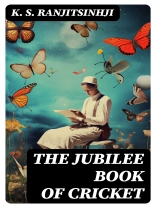In ‚The Jubilee Book of Cricket, ‚ K. S. Ranjitsinhji offers a rich tapestry of the history and evolution of cricket, interwoven with personal anecdotes and insights from his illustrious career as both a player and an advocate for the sport. The book employs a vibrant, engaging prose style that captures not only the technical aspects of cricket but also its cultural significance during the late Victorian era. Ranjitsinhji’s narrative flourishes within a context marked by the burgeoning popularity of cricket in England and its colonial realms, providing readers a unique perspective on the interplay between sportsmanship and social dynamics of his time. Ranjitsinhji, a pioneering cricketer from India, emerged as a groundbreaking figure in the early 20th century, celebrated for his remarkable batting technique and elegant style. Growing up in a princely state amid traditions and expectations, he broke barriers as both a cricketer and an author. His insights draw from a lifetime of experiences that offered him a nuanced understanding of the sport’s potential for bridging cultural divides, showcasing his commitment to promote cricket as a global language of camaraderie. This book is highly recommended for cricket enthusiasts, historians, and anyone interested in the intersection of sports and cultural identity. Ranjitsinhji’s eloquent prose and in-depth analysis make it an essential read that not only celebrates cricket but also invites readers to appreciate its deeper significance in society.
Über den Autor
Kumar Shri Ranjitsinhji, better known as K. S. Ranjitsinhji or ‚Ranji, ‚ was an Indian prince and an iconic figure in the world of cricket. He is often celebrated for his elegant batting style and for being one of the most prominent cricketers to popularize the leg glance. Born in 1872 in the princely state of Nawanagar, Ranjitsinhji ascended to cricketing greatness through sheer talent and determination. His seminal work, ‚The Jubilee Book of Cricket‘ (1897), provides an expansive discourse on the game and reflects his deep understanding and love for cricket. The book covers everything from the history of cricket, instructions, and its development, to personal anecdotes and insights into batting technique, illustrating Ranjitsinhji’s analytical approach to the sport. Ranjitsinhji’s literary contribution, encapsulated in this work, is a significant aspect of cricket historiography. His impact was not limited to the cricket field or literary endeavors, as he also played a vital role in India’s princely politics and served as Maharaja Jam Saheb of Nawanagar. In recognition of his prowess, the Ranji Trophy, a premier first-class cricket championship in India, was established in his honor in 1934. His unique synthesis of princely pedigree with sport and literature adds an enriching dimension to his biography. He passed away in 1933, leaving a legacy as both an innovative cricketer and an insightful author, celebrated in the annuls of cricket history.












